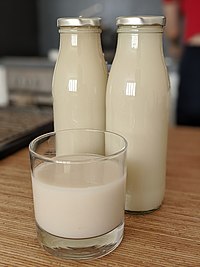
Photo from wikipedia
Heating milk at high temperatures impairs its renneting properties, but rennet-induced curds can be formed from ultra-high temperature (UHT) milk inoculated with Saccharomyces cerevisiae. Herein, we measured physicochemical indices of… Click to show full abstract
Heating milk at high temperatures impairs its renneting properties, but rennet-induced curds can be formed from ultra-high temperature (UHT) milk inoculated with Saccharomyces cerevisiae. Herein, we measured physicochemical indices of UHT milk inoculated with S. cerevisiae before rennet addition, monitored the kinetics of gel formation, and investigated the physicochemical properties and microstructure of rennet-induced curds to explore the mechanisms by which S. cerevisiae influenced rennet-induced gelation of UHT milk. Compared with untreated pasteurized cow milk and UHT milk, the ethanol content was increased, the pH was decreased, the particle size and ζ-potential were increased, the time points at which the elasticity index began to increase were advanced, and the maximum elasticity index was increased for UHT milk inoculated with S. cerevisiae. The number of S. cerevisiae cells affected the structure of rennet-induced curds; with few cells added, the protein network of curds was continuous and tight, the mean square displacement curves showed an asymptotic behavior, and the water retention capacity and curd yield were high; with more cells added, the loosely entangled proteins aggregated, the continuity of the network was destroyed, and the curd yield decreased. In summary, a low number of S. cerevisiae cells (<1.0 × 107 cfu/mL) can increase particle size, ζ-potential, and ethanol content, and decrease pH of S. cerevisiae-inoculated UHT milk, thereby accelerating the aggregation reactions after enzymatic reaction and improving the renneting properties.
Journal Title: Journal of dairy science
Year Published: 2022
Link to full text (if available)
Share on Social Media: Sign Up to like & get
recommendations!